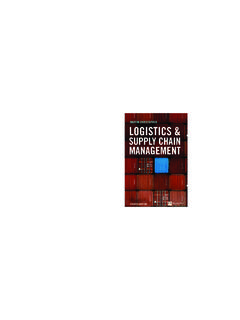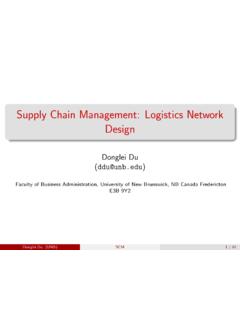Transcription of A Framework for Operations Strategy - MIT …
1 A Framework for Operations Strategy How Operations can be used for competitive advantage in today's world Problem One: Conflicts More capacity Better forecasts Variety Economical Operations Cost Other strategic criteria Meeting targets Maintaining quality 2. Problem Two: Role in Strategy Marketing Sales Finance Strategic R&D Planning Corporate Plans Manufacturing 3. We first address some business Strategy issues Which businesses should we be in? How do we compete and compare with our competitors in each one? What dimensions of customer performance do we focus on To answer these questions, we first look at alternative views of how individual businesses compete 4. Competitive Strategy : The Positioning View Sources of Barriers to Entry Economies of scale Product differentiation and brand loyalty Capital requirements Switching costs Access to distribution channels Cost disadvantages independent of scale Proprietary product technology Favorable access to raw materials Favorable locations Government subsidies Learning or experience curve Government policy New Entrants threat Suppliers Have Power When: Buyers Have Power When.
2 Fewer suppliers than those supplied Buyers are concentrated or purchase large No substitute products volumes relative to industry sales Industry is not an important customer Purchases represent a significant Suppliers' input is important to industry fraction of their costs Suppliers Buyers Supplier products are differentiated or Products purchased are standard or switching costs are high undifferentiated Suppliers may forward integrate bargaining bargaining Buyers face few switching costs power Industry Competitors power Buyers earn low profits Buyers can backward integrate Products purchased are unimportant to quality of buyers' products Buyer has full information Sources of Intense Rivalry Substitutes May Become a Threat When: threat Numerous or equally balanced competitors Good price performance Slow industry growth Low switching costs High fixed or storage costs Industry is willing to substitute Capacity augmented in large increments Diverse competitors Substitutes 5 High strategic stakes High exit barriers Source: Adapted from Porter Competitive Strategy : The Positioning View Positioning is based on the external market, industry dynamics, and the structure of the value chain volume growth Time 6.
3 Competitive Strategy : The Positioning View Options for firm positioning: Cost leadership Differentiation And, by focusing on segments Distinct customer groups Groups with similar needs BUT, assumes Operations excellence is not a source of competitive advantage 7. Competitive Strategy : The Resource-Based View Competitive advantage is derived from the firm's development of unique bundles of resources and capabilities that are: Inimitable: are difficult or costly to imitate or replicate Valuable: allow the firm to improve its market position relative to competitors Rare: in relatively short supply 8. Competitive Strategy : The Resource-Based View Resource: an observable, but not necessarily tangible, asset that can be valued and traded , brand, patent, parcel of land, license Asset or input to production than an organization owns, controls or has access to on a semi-permanent basis Capability: not observable, and hence necessarily intangible, cannot be valued and changes hands only as part of an entire unit Processes, activities or functions performed within a system Utilize the organization's resources Example: How a company innovates 9.
4 Competitive Strategy : The Resource-Based View Types of capabilities Process-based , McDonald's Systems- or coordination-based , Ritz-Carlton , Southwest Airlines Organization-based , Toyota Network-based , Dell and the fulfillment supply chain , Cisco and the technology suppliers 10. Competitive Strategy : Integrating the Positioning and Resource-Based Views Capabilities Positioning Process Cost Coordination Leadership Organization Differentiation Network Focus 11. The process must then involve three levels: Corporate Business Unit Function 12. as well as customer goals Cost Quality Availability Features/Innovativeness Environmental Performance 13. yielding an integrated Framework Complementors Competitors Customers Cost Quality Availability Features/. Innovativeness Environmental Performance Capabilities Positioning Business Strategy Cross-Functional Integration (Fit). Suppliers Finance and Operations Accounting Time Delay Marketing Human Resources Research and Development Functional Strategies 14.
5 The essence is internal/external and functional fit External Industry Forces Internal Influences Influences - Industry attractiveness - Competitive structure: opportunities and threats Strategic Plan: Goals Organization's Gaining and Maintaining Objectives Culture . Competitive Advantage - Capabilities: Sources of - Competitive strengths/weaknesses priorities Functional Strategies Mktg. Ops. Finance R&D. 15. But there is a fourth level! Fourth level: Decision Category Approach The decision category approach examines manufacturing decision categories for consistency with strategic vision Structural decisions Bricks and mortar Machinery Infrastructure People Systems Procedures Fit with business, corporation, and other functions 16. Companies vary considerably on this ideal approach Use of both capabilities and positioning Formality of process Type of formal method Input of Operations Focus on all decision categories 17. Major Manufacturing Decision Categories 1.
6 FACILITIES 6. INFORMATION TECHNOLOGIES. size use and level of investment location parity or differentiation focus 7. SUPPLY CHAIN AND MATERIALS (The fulfillment supply chain). 2. CAPACITY. logistics facilities and methods amount inventory policies timing vendor relations type production planning 3. VERTICAL INTEGRATION AND SUPPLIER management . (The technology supply chain) 8. ORGANIZATION AND INCENTIVES. direction structure extent reporting levels interfaces degree of centralization collaboration role of staff 4. PRODUCTION TECHNOLOGIES AND PROCESSES control/reward systems equipment costing systems automation 9. BUSINESS PROCESSES. product generation interconnectedness interfaces scale responsibilities flexibility vendor development 5. WORK FORCE AND management . order fulfillment RFI? service and support Policies (wages, security, etc.). quality and CI, flexibility, and skill levels other cross-cutting capabilities 18. IT decisions How much to invest Where to focus investment Standardized or customized applications Should IT be standardized within the company Standardization allows common learning and implementation advantages But there is less flexibility for local needs Organization, implementation and measurement Parity or competitive advantage 19.
7 Measures of Performance The strategic mission matches the organization's strengths to a limited set of external measures of performance Operations Costs Quality Unit costs Return rate Total (volume) costs Product reliability and durability Lifetime costs Cost and rate of field repairs Availability Innovativeness and Features Percentage of on-time Product innovativeness shipments Time to market and Response to results for info development cycle or changes Environmental Performance Product and volume flexibility Ease of disassembly and Delivery time recycling Use of resources 20. Decision Categories map to 3D. concurrent engineering Product Process Supply Chain Process technology Fulfillment SC. Capacity Materials mgmt Facilities Supplier mgmt IT Vertical integration Business Processes- PG. Infrastructure HR, organization, IT infrastructure, other business processes 21. Identify the right measures! 22. The Classic Strategies Strategy Technology Infrastructure Marketing & Sales Materials planning Narrow line Low unit cost Specialized equipment and control Price High service level Reserve capacity Inventory Dependability Wide line custom Flexible machines Customer needs Worker skills products Reserve capacity and scheduling Development Market leadership Product innovation General purpose Team skills New segments 23.
8 Present Operations Policies Operations Unit Decision Description of Past Policy Strengths Weaknesses Category Production technologies & processes Capacity Workforce &. management 24. Summary of decision category Framework Understanding of external (value chain, dynamics, competitors, etc.) and internal (capabilities). Consistency at four levels (corporation, business, function, and decision category). Strategy is pattern of decisions within the nine categories Strategy is the identification of the competitive priorities from the five means of competition 25. MIT OpenCourseWare Operations Strategy Fall 2010. For information about citing these materials or our Terms of Use, visit.












